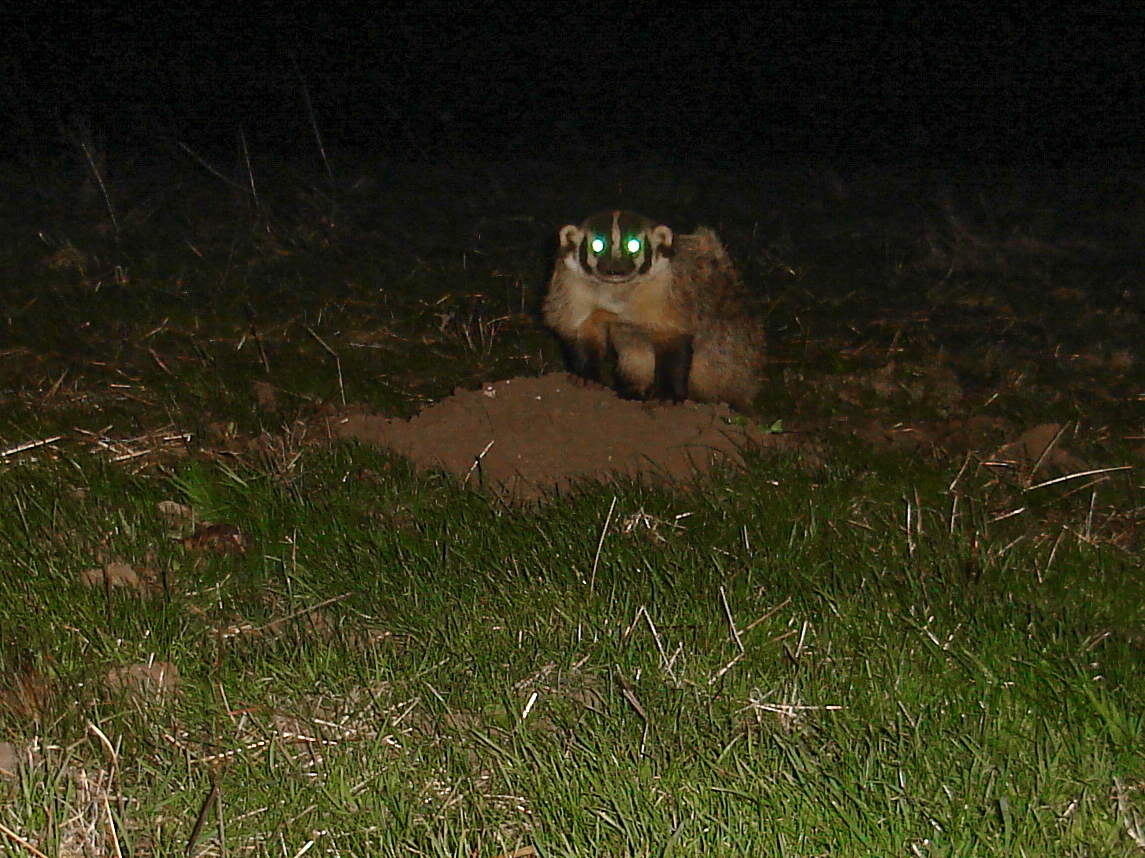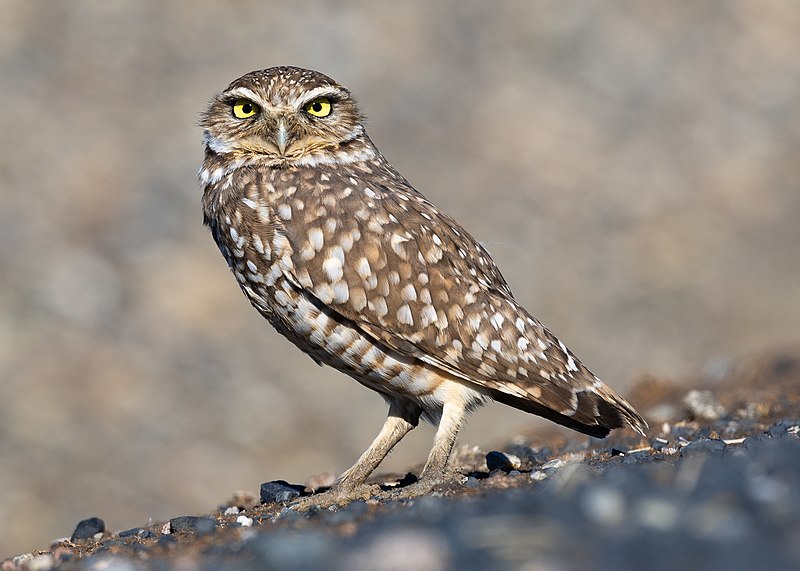Since 2019, TomKat has been coordinating with Wildlife Biologist Karine Tokatlian, Resource Management Specialist at Midpeninsula Regional Open Space to understand badgers and burrowing owls and their fascinating relationship.
Badgers and Burrowing Owls

Badger caught in the act. Photo by Ken Hickman.
02/21/2025
By: Wendy Millet and Karine Tokatlian, Midpen Open Space Trust
Since 2019, TomKat has been coordinating with Wildlife Biologist Karine Tokatlian, Resource Management Specialist at Midpeninsula Regional Open Space to understand badgers and burrowing owls and their fascinating relationship. Karine notes: “We know badgers are present in the area, beneficial to the ecosystem, and a species of special concern.” However, we don’t know much else about them including their population condition, distribution, and how best to manage them on the peninsula. As burrowing owls occupy badger dens after badgers vacate, protecting badgers benefits both species–owls and badgers–further increasing our interest to understand badgers and their dynamics within the ecosystem.
In case you don’t know much about badgers, a few highlights from Jessie Qunin one of the few badger experts in the state. Badgers are in the Weasel family; there are four subspecies. These burrowing carnivores are found in open grasslands in all elevations and eat mostly ground squirrels and pocket gophers. Their range is typically 1-10 square miles, and they can move seven miles/hour. This nocturnal creature weighs in at 11-18 lbs (females) and 30 lbs (males) (bigger ones tend to be seen in Canada). They have few natural predators but are susceptible to Canine distemper and several anthropogenic issues, including vehicle strikes and rodenticide poisoning.

Western Burrowing Owl - Glenn County
Badgers are carnivores whose primary food sources are burrowing rodents like ground squirrels and pocket gophers. They tend to decimate gopher populations in a given area before they move on.
At night, badgers dig dens to sleep in at depths of 5-10 feet. These dens are key not just for the badgers, but also for burrowing owls who average 9” tall and rely on burrows of ground squirrels and badgers or erosion gulleys where they can find a small hole. These rare and tiny owls prefer areas with multiple burrows and short grasses nearby so they can hunt near safety.
From 2019 to 2022, Karine and other researchers conducted survey transects by walking the hills in search of badger burrows and hair samples at soil mounds (No handling necessary). TomKat Ranch was one of the only private ranches surveyed and contributed invaluable knowledge about badgers along the coast. In the first year of this research period, in 2019, Karine noted “a lot of badger signs (diggings and burrows) at TomKat,” and one male confirmed using genetic analysis of a hair sample. Weasels were also found to be using the badger burrows. A linkage model was created to show the best pathway of movement for badgers through the peninsula, and it runs right through the grasslands of TomKat Ranch. Through this project, a total of 103 samples were collected but only 36% of them amplified successfully in the lab to be usable for analysis. Preliminary results suggest a small population of badgers that are likely isolated on the peninsula with low genetic diversity. Only one owl was observed during the transects, but evidence of owls was found at badger burrows and erosion gulleys along coastal grasslands. Overall, it can be concluded that more monitoring and sampling needs to be done to draw a more robust understanding of the findings.
In 2022, Karine gave a presentation of her study to TomKat Ranch staff followed by an in-depth discussion about the important role of badgers in the ecosystem and of badger conservation management actions in coastal ranching areas. Here are some of the highlights:
Habitat and population dynamics of badgers and the benefits they provide:
- They favor healthy grasslands of 1-3 feet high, not too tall that they can’t get through grass but enough to give them cover.
- Lack of historical grazing and fire impacts have changed the balance of habitats for these grassland-loving species.
- Peninsula populations show signs of being isolated, small, and less genetically diverse than other populations. More genetic sampling is needed to finalize the results.
- One sample collected from TomKat Ranch was from a male badger who had a second-order relative found 7.5 miles away in MidPen’s La Honda Creek preserve!
- Their digging breaks up compacted soils and distributes nutrients, making them an important “ecosystem engineer.”
- They help manage gophers who especially thrive during dry years.
Conservation actions landowners can take:
- Restore and maintain grasslands.
- Understand grassland height. Badgers prefer medium grass height (up to knee), but a variety of grass heights can also be kept to help badgers move more easily through their habitats.
- Manage brush encroachment. Maintain pastures at <30% brush.
- Grazing/mowing helps grasses from getting too high or overgrown for these species; these management practices help maintain grassland habitat for badger habitat and connectivity.
- Variations and heterogeneity in habitat (e.g., water features, some brush, variety of native species, different grass heights) help to support different biological needs and life stages while maintaining large and connected patches of grassland.
- Remove hard barriers and make infrastructure “wildlife friendly” (e.g., remove the bottom wire on fencing, avoid using deer fencing, only use single strands, and make culverts large enough for mesocarnivores to pass through).
- Discourage trapping or hazing of badgers.
- Learn how you can support badger habitat and contribute to data collection by providing researchers access or sharing any badger location information you know of.
- Contribute to data collection efforts by offering researchers access to your land and/or information about badger locations on your property.
Midpen is leading a regional conversation effort to encourage badger conservation. In 2024, they created an American Badger Linkage Model showing that the best movement pathway for badgers through the peninsula runs through the grasslands of TomKat Ranch. We look forward to supporting MidPen in their efforts to support habitat for these unique species!
Contact Karine Tokatlian if you want to be involved:ktokatlian@openspace.org